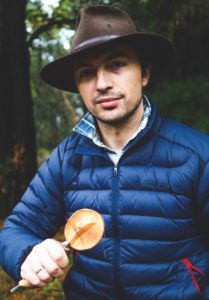Mushrooms: Wild About Mushrooms
Whether farmed in abandoned railways, foraged in forests or researched for health and flavour benefits – we’re obsessed with fungi.
The ‘fifth’ Taste
Mushrooms are not actually a vegetable or even a plant. Classed as a type of fungus, and part of their own ‘kingdom’, biologically we have more in common with a mushroom than we think, as mushrooms ‘breathe’ oxygen while expelling carbon dioxide compared to plants who do the reverse
Director of Mycelia Organics and Owner of The Organic Mushroom Farm, Chris McLoghlin explains,“Until recently Westerners still believed the human palate consisted of only salt, sweet, sour and bitter, while Japanese scientists had already discovered a fifth addition which they called, Umami; a common Japanese word meaning ‘savoury’ or ‘deliciousness’.”
Umami is described as a savoury taste, which is found in broth, parmesan cheese, tomatoes and fermented foods, such as soy sauce.
Some foods need to be cooked in order to draw out their umami flavour; meat is a great example of this. Raw meat isn’t umami, yet when cooked slowly it releases amino acids; which are responsible for the delicious umami, meaty flavour experience.
Mushrooms have a strong umami flavour thanks to the amino acid, glutamate that has even been isolated and produced into the infamous monosodium glutamate or more commonly known, ‘MSG’. This common food flavouring is added to everything from tinned soup, cereal and noodles, to baby food.


Did You Know
Mushrooms are the sixth most valuable horticultural crop and the third most valuable fresh produce item in the vegetable section of the supermarket after potatoes and tomatoes.
About half the child population either like or love mushrooms and over 90 per cent of people over the age of 25 either like or love mushrooms.
98 per cent of mushroom eaters believe mushrooms add something special to a dish.
The mushroom is neither a fruit nor a vegetable. All mushrooms come from a completely different living kingdom, the mushroom kingdom, or what we call the ‘Third Food Kingdom’.
Because it is from a different food kingdom, the mushroom has a very different nutrition profile and has antioxidants and bioactive compounds not found in plants.
The mushroom, like humans, generates vitamin D when it is in the sunlight. Putting your mushrooms in the sunshine for 30-60 minutes will get them to start producing vitamin D.
Some Australian farmers have produced mushrooms with the daily needs of vitamin D in a single 100g serve, about three button mushrooms.
An Underground History
Mushroom growing in Australia began in 1933 with the popular European varieties of button, cup, flat and portobello grown commercially in abandoned railway tunnels under Sydney and throughout New South Wales.
Towards the late 1930’s mushroom farming evolved with the design of the first raised beds and the enterprise was taken outdoors. With fragile mushrooms exposed to our harsh Australian climate, it was hard going in the first few years. With the help of new European migrants the Australian mushroom industry went on to became a successful seasonal produce.


Farming and Foraging
The mushroom industry has been sustainable long before it was trendy. Known as the ‘ultimate recycler’, mushroom food is made from straw, poultry litter, other organic materials and water. When carefully combined, they provide the perfect nutrient mix to harvest mushrooms.
Once a Mushrooms: Wild About Mushrooms harvest is picked, the mushroom waste goes back into the environment as an excellent potting mix and garden mulch.
With mushrooms now grown inside allows farmers to manipulate the conditions witinin the ‘growing rooms’ by using climate control computer systems. This system manages carbon dioxide levels, temperature, humidity and airflow.
For mushrooms to propagate the farm recreates the conditions of a thunderstorm; with a build up of carbon dioxide; a quick drop in temperature, an increase in humidity and then a dump of water; all this tricks the mushrooms into reproducing.
“At this stage they grow about a millimetre an hour,” Chris says.
“Once the mushrooms are harvested, over a few days, a second generation will come through; we then empty the room and send the composts to another compost company for their use
With every mushroom you see in the supermarket being handpicked or hand cut before being placed into a punnet or box, Chris describes their labour costs as one of the highest in the horticulture industry.
“The labour cost in Australia is upwards of 30 to 35 per cent for mushroom farms,” he explains.
“Mushrooms can be a volatile pricing environment with fewer farms than there were 20 years ago and much bigger.
“There were about 140 odd farms 20 years-ago, there’s about 40 now.”
“As the case with all markets, when you have a concentrated supplier base any difference in their production can generate disproportionally large swings in supply and demand and therefore price.
Mushrooms in Australia can now be grown year-round thanks to farming in a controlled environment.
“Pretty much every mushroom farm in Australia is picking 365 days a year, but there’s a season in the sense that the winter months are close to it’s natural growing environment; so you spend a lot less energy to maintain the climate,” Chris says.
In the wild you’ll find edible mushrooms, and their poisonous cousins, thriving in our lush rainforests. With the paddock-to-plate trend rising, mushroom foraging tours are now popular among foodies and high-profile chefs who enjoy the educational and tasty experience. Chris and his team at The Organic Mushroom Farm hold foraging tours and insist that wild mushroom foraging should only be done with a professional; with fatal varietys easily confused with edible fungi.
Baking with Mushrooms
Mushrooms ‘meaty’ type texture and umami flavour profile are perfect as a meat replacement or to bulk out meat in pies and pasties.
Don’t wash mushrooms; simply wipe the dirt from them with a clean cloth and store mushrooms in a brown paper bag; never in a plastic bag.
“Create your own natural umami paste by cooking mushrooms until the juice fills the cup of the mushroom, pour into a jar and store in the fridge for a few days and cook it down to a reduction to use in dishes for a strong mushroom flavour,” Chris says.
“Grill mushrooms with the gills up so the water from the mushrooms rises and pools in the gills, ensure when it’s lifted out of the pan that the ‘juice’ remains.”








COMMENTS